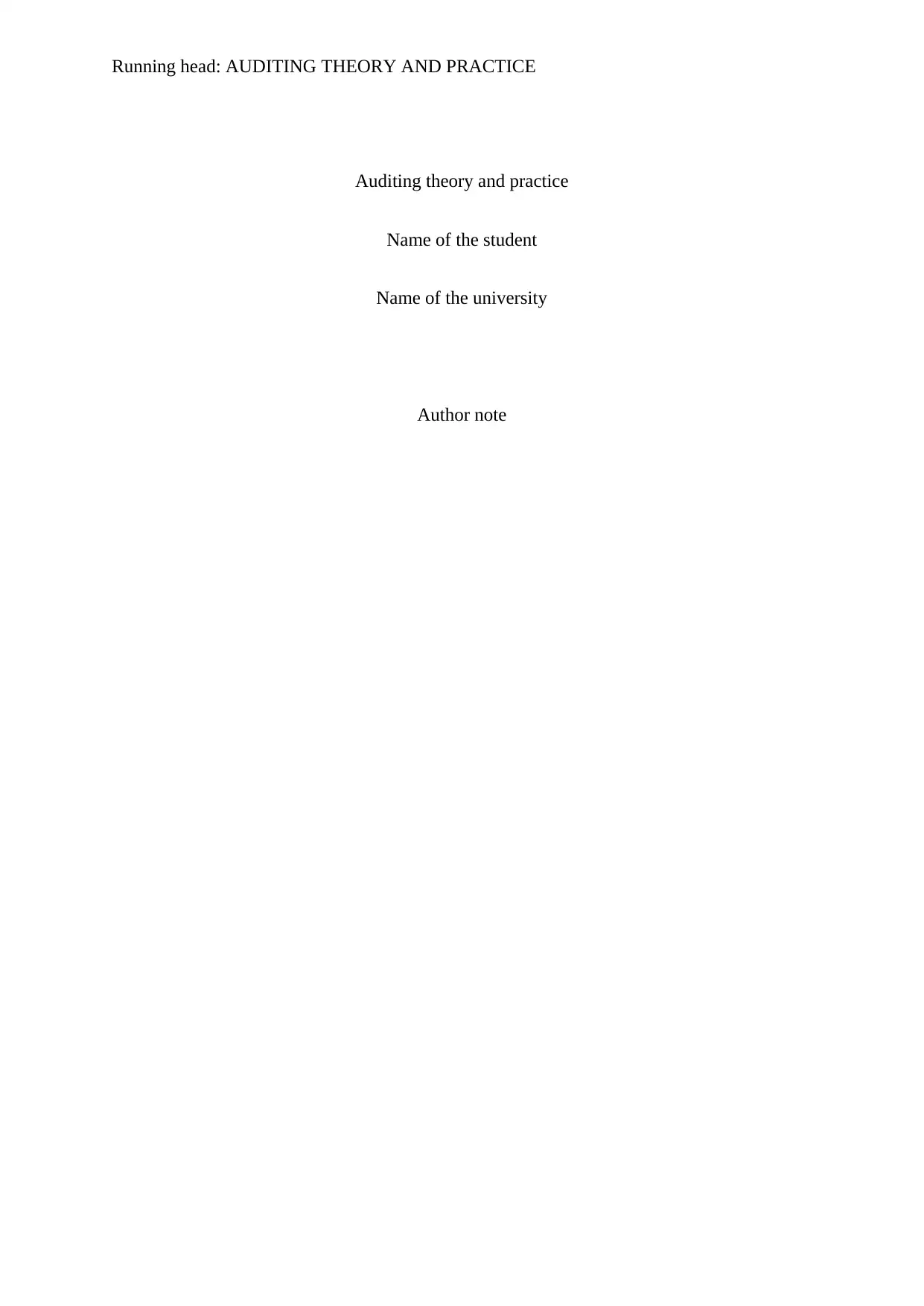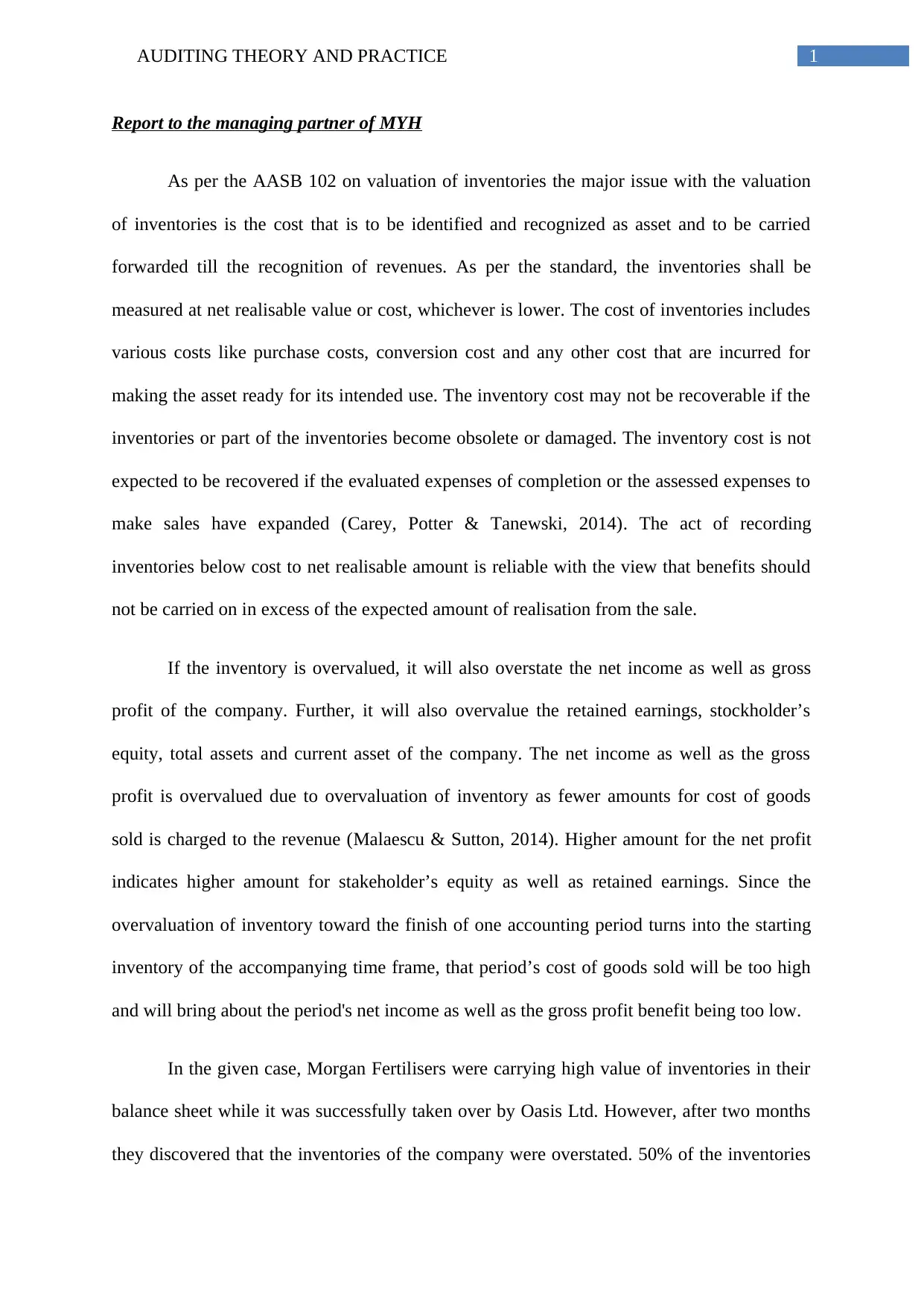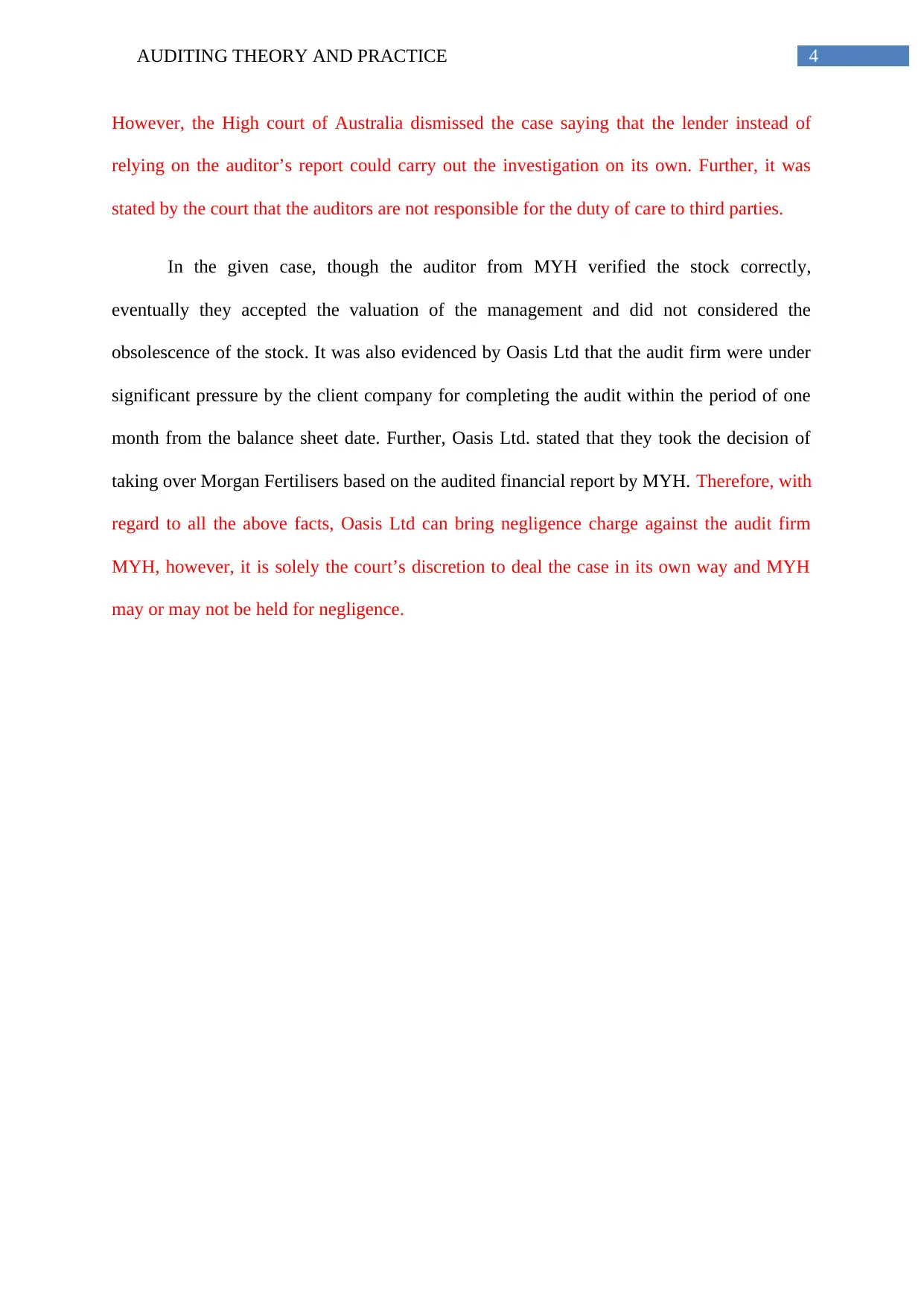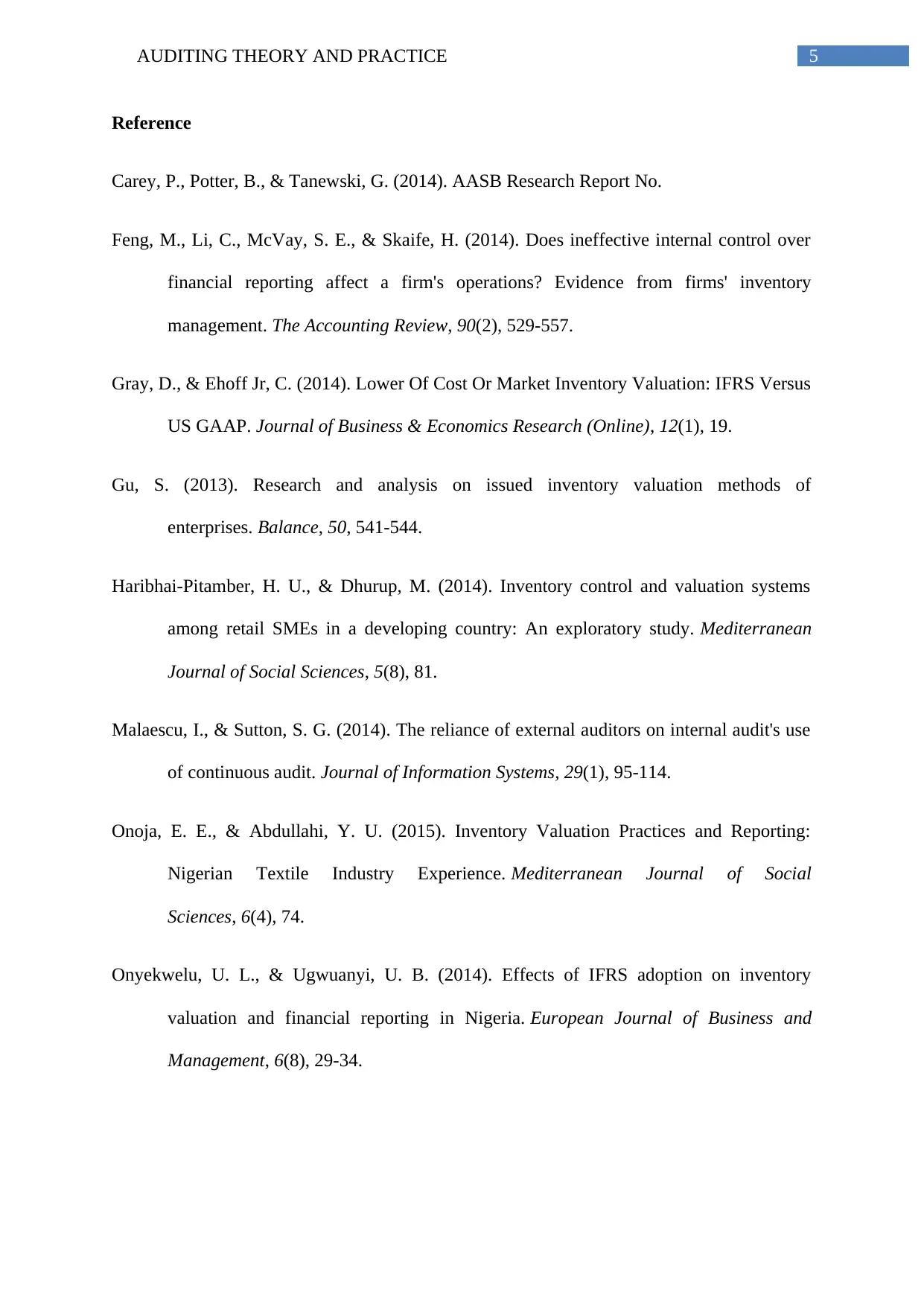Auditing Theory and Practice Report: Inventory Valuation and Audit
VerifiedAdded on 2020/03/02
|7
|1674
|41
Report
AI Summary
This report delves into auditing theory and practice, focusing on inventory valuation as per AASB 102. It examines the auditor's role in verifying inventory, emphasizing the importance of physical confirmation and adherence to auditing standards. The report analyzes the consequences of inventory misstatements, including overvaluation and its impact on financial statements. It also explores auditor liability, discussing scenarios where auditors can be held liable for negligence, and cites the Esanda Finance Corporation case as an example. The report highlights the pressures faced by auditors and the importance of professional judgment in ensuring accurate financial reporting, ultimately addressing the potential for negligence charges against auditing firms like MYH.

Running head: AUDITING THEORY AND PRACTICE
Auditing theory and practice
Name of the student
Name of the university
Author note
Auditing theory and practice
Name of the student
Name of the university
Author note
Paraphrase This Document
Need a fresh take? Get an instant paraphrase of this document with our AI Paraphraser

1AUDITING THEORY AND PRACTICE
Report to the managing partner of MYH
As per the AASB 102 on valuation of inventories the major issue with the valuation
of inventories is the cost that is to be identified and recognized as asset and to be carried
forwarded till the recognition of revenues. As per the standard, the inventories shall be
measured at net realisable value or cost, whichever is lower. The cost of inventories includes
various costs like purchase costs, conversion cost and any other cost that are incurred for
making the asset ready for its intended use. The inventory cost may not be recoverable if the
inventories or part of the inventories become obsolete or damaged. The inventory cost is not
expected to be recovered if the evaluated expenses of completion or the assessed expenses to
make sales have expanded (Carey, Potter & Tanewski, 2014). The act of recording
inventories below cost to net realisable amount is reliable with the view that benefits should
not be carried on in excess of the expected amount of realisation from the sale.
If the inventory is overvalued, it will also overstate the net income as well as gross
profit of the company. Further, it will also overvalue the retained earnings, stockholder’s
equity, total assets and current asset of the company. The net income as well as the gross
profit is overvalued due to overvaluation of inventory as fewer amounts for cost of goods
sold is charged to the revenue (Malaescu & Sutton, 2014). Higher amount for the net profit
indicates higher amount for stakeholder’s equity as well as retained earnings. Since the
overvaluation of inventory toward the finish of one accounting period turns into the starting
inventory of the accompanying time frame, that period’s cost of goods sold will be too high
and will bring about the period's net income as well as the gross profit benefit being too low.
In the given case, Morgan Fertilisers were carrying high value of inventories in their
balance sheet while it was successfully taken over by Oasis Ltd. However, after two months
they discovered that the inventories of the company were overstated. 50% of the inventories
Report to the managing partner of MYH
As per the AASB 102 on valuation of inventories the major issue with the valuation
of inventories is the cost that is to be identified and recognized as asset and to be carried
forwarded till the recognition of revenues. As per the standard, the inventories shall be
measured at net realisable value or cost, whichever is lower. The cost of inventories includes
various costs like purchase costs, conversion cost and any other cost that are incurred for
making the asset ready for its intended use. The inventory cost may not be recoverable if the
inventories or part of the inventories become obsolete or damaged. The inventory cost is not
expected to be recovered if the evaluated expenses of completion or the assessed expenses to
make sales have expanded (Carey, Potter & Tanewski, 2014). The act of recording
inventories below cost to net realisable amount is reliable with the view that benefits should
not be carried on in excess of the expected amount of realisation from the sale.
If the inventory is overvalued, it will also overstate the net income as well as gross
profit of the company. Further, it will also overvalue the retained earnings, stockholder’s
equity, total assets and current asset of the company. The net income as well as the gross
profit is overvalued due to overvaluation of inventory as fewer amounts for cost of goods
sold is charged to the revenue (Malaescu & Sutton, 2014). Higher amount for the net profit
indicates higher amount for stakeholder’s equity as well as retained earnings. Since the
overvaluation of inventory toward the finish of one accounting period turns into the starting
inventory of the accompanying time frame, that period’s cost of goods sold will be too high
and will bring about the period's net income as well as the gross profit benefit being too low.
In the given case, Morgan Fertilisers were carrying high value of inventories in their
balance sheet while it was successfully taken over by Oasis Ltd. However, after two months
they discovered that the inventories of the company were overstated. 50% of the inventories

2AUDITING THEORY AND PRACTICE
those were already being obsolete and were not supposed to be included under the valuation
were counted under the inventory. Further, the other inventories were valued at 35% more
than the actual value. Moreover, though the audit firm MYH correctly valued the stock,
finally they accepted the valuation of the management.
Physical confirmation of inventories is the duty of entity’s management. It is
management’s duty to build up strategies for checking of inventories at least once in a year to
establish a basis for the financial statement preparation. The auditor needs to complete review
techniques to get adequate and suitable audit confirmation during his participation at the time
of tallying of physical inventory (Reineking et al., 2013). The auditor is ought to be
physically present to inspect and investigate the inventory and to survey whether the systems
set around by the management to record and control the changes of the checking are being
agreed to and to choose the dependability of such procedures. If the auditor cannot go for the
inventory count, he is ought to be available on an optional date and settle on alternative
measures to evaluate whether the adjustments in the inventories between the year end and the
date of physical count are accurately recorded (Feng, McVay & Skaife, 2014). The auditor
must analyze the outward and inward movement of stocks from cut-off date till the physical
count date for establishing the data validity on the closing date of the year.
Further, the auditor shall review the internal control and management’s instructions
with regard to the tagging, stock sheets, re-counting and counting of stocks, identification of
obsolete, slow-moving, rejected or damaged items from the inventories and give appropriate
impact on the financial statement (Onyekwelu & Ugwuanyi, 2014). He shall also consider the
cut-off procedures, valuation of the work-in-progress and movement of the inventories.
However, where the auditor is not able to obtain the appropriate and sufficient evidence with
regard to the condition and existence of inventory and offending process for the physical
count of the inventory, the auditor shall make the reference in the audit report regarding the
those were already being obsolete and were not supposed to be included under the valuation
were counted under the inventory. Further, the other inventories were valued at 35% more
than the actual value. Moreover, though the audit firm MYH correctly valued the stock,
finally they accepted the valuation of the management.
Physical confirmation of inventories is the duty of entity’s management. It is
management’s duty to build up strategies for checking of inventories at least once in a year to
establish a basis for the financial statement preparation. The auditor needs to complete review
techniques to get adequate and suitable audit confirmation during his participation at the time
of tallying of physical inventory (Reineking et al., 2013). The auditor is ought to be
physically present to inspect and investigate the inventory and to survey whether the systems
set around by the management to record and control the changes of the checking are being
agreed to and to choose the dependability of such procedures. If the auditor cannot go for the
inventory count, he is ought to be available on an optional date and settle on alternative
measures to evaluate whether the adjustments in the inventories between the year end and the
date of physical count are accurately recorded (Feng, McVay & Skaife, 2014). The auditor
must analyze the outward and inward movement of stocks from cut-off date till the physical
count date for establishing the data validity on the closing date of the year.
Further, the auditor shall review the internal control and management’s instructions
with regard to the tagging, stock sheets, re-counting and counting of stocks, identification of
obsolete, slow-moving, rejected or damaged items from the inventories and give appropriate
impact on the financial statement (Onyekwelu & Ugwuanyi, 2014). He shall also consider the
cut-off procedures, valuation of the work-in-progress and movement of the inventories.
However, where the auditor is not able to obtain the appropriate and sufficient evidence with
regard to the condition and existence of inventory and offending process for the physical
count of the inventory, the auditor shall make the reference in the audit report regarding the
⊘ This is a preview!⊘
Do you want full access?
Subscribe today to unlock all pages.

Trusted by 1+ million students worldwide

3AUDITING THEORY AND PRACTICE
limitation scope (Gu, 2013). Moreover, if the inventory is not disclosed appropriately in the
financial statements, a qualified opinion shall be issued by the auditor.
The auditor is evaluated against the auditing standard that obliges the auditor to apply
professional judgement while auditing. Through the auditors are not held responsible
automatically for detecting the fraud. However, he is required to consider the risk with regard
to fraud and plan the audit accordingly. Oasis Ltd. can bring the negligence charge against
the auditor for not carrying out his audit as per the requirement of the auditing standards
(Haribhai-Pitamber & Dhurup, 2014).
Further, as per the general rule, the auditor is not liable towards the third parties and
he is liable to his client only. However, if third parties prove the below mentioned points then
the auditor will be liable towards the third parties –
The financial statement was not true in fact
That the auditor intentionally or consciously or recklessly ignored a fact knowing it
to be untrue (Gray & Ehoff Jr, 2014).
Errors were committed in the final accounts preparation
Negligence committed by auditor’s employee
The third party acted on the basis of audited financial statement
That the financial statement was prepared intentionally that third party shall act upon
the statement (Onoja & Abdullahi, 2015).
In the case of Esanda Finance Corporation Ltd v Peat Marwick Hungerfords
(1997), Esanda Finance Corporation, the appellant, lend money to the an organization based
on the audit report shown by Peat Marwick Hungerfords. However, after borrower default on
the payment, Esanda claimed to the auditors justifying that they have provided loan based on
the issued audit report by the auditor that breached the compulsory accounting standard.
limitation scope (Gu, 2013). Moreover, if the inventory is not disclosed appropriately in the
financial statements, a qualified opinion shall be issued by the auditor.
The auditor is evaluated against the auditing standard that obliges the auditor to apply
professional judgement while auditing. Through the auditors are not held responsible
automatically for detecting the fraud. However, he is required to consider the risk with regard
to fraud and plan the audit accordingly. Oasis Ltd. can bring the negligence charge against
the auditor for not carrying out his audit as per the requirement of the auditing standards
(Haribhai-Pitamber & Dhurup, 2014).
Further, as per the general rule, the auditor is not liable towards the third parties and
he is liable to his client only. However, if third parties prove the below mentioned points then
the auditor will be liable towards the third parties –
The financial statement was not true in fact
That the auditor intentionally or consciously or recklessly ignored a fact knowing it
to be untrue (Gray & Ehoff Jr, 2014).
Errors were committed in the final accounts preparation
Negligence committed by auditor’s employee
The third party acted on the basis of audited financial statement
That the financial statement was prepared intentionally that third party shall act upon
the statement (Onoja & Abdullahi, 2015).
In the case of Esanda Finance Corporation Ltd v Peat Marwick Hungerfords
(1997), Esanda Finance Corporation, the appellant, lend money to the an organization based
on the audit report shown by Peat Marwick Hungerfords. However, after borrower default on
the payment, Esanda claimed to the auditors justifying that they have provided loan based on
the issued audit report by the auditor that breached the compulsory accounting standard.
Paraphrase This Document
Need a fresh take? Get an instant paraphrase of this document with our AI Paraphraser

4AUDITING THEORY AND PRACTICE
However, the High court of Australia dismissed the case saying that the lender instead of
relying on the auditor’s report could carry out the investigation on its own. Further, it was
stated by the court that the auditors are not responsible for the duty of care to third parties.
In the given case, though the auditor from MYH verified the stock correctly,
eventually they accepted the valuation of the management and did not considered the
obsolescence of the stock. It was also evidenced by Oasis Ltd that the audit firm were under
significant pressure by the client company for completing the audit within the period of one
month from the balance sheet date. Further, Oasis Ltd. stated that they took the decision of
taking over Morgan Fertilisers based on the audited financial report by MYH. Therefore, with
regard to all the above facts, Oasis Ltd can bring negligence charge against the audit firm
MYH, however, it is solely the court’s discretion to deal the case in its own way and MYH
may or may not be held for negligence.
However, the High court of Australia dismissed the case saying that the lender instead of
relying on the auditor’s report could carry out the investigation on its own. Further, it was
stated by the court that the auditors are not responsible for the duty of care to third parties.
In the given case, though the auditor from MYH verified the stock correctly,
eventually they accepted the valuation of the management and did not considered the
obsolescence of the stock. It was also evidenced by Oasis Ltd that the audit firm were under
significant pressure by the client company for completing the audit within the period of one
month from the balance sheet date. Further, Oasis Ltd. stated that they took the decision of
taking over Morgan Fertilisers based on the audited financial report by MYH. Therefore, with
regard to all the above facts, Oasis Ltd can bring negligence charge against the audit firm
MYH, however, it is solely the court’s discretion to deal the case in its own way and MYH
may or may not be held for negligence.

5AUDITING THEORY AND PRACTICE
Reference
Carey, P., Potter, B., & Tanewski, G. (2014). AASB Research Report No.
Feng, M., Li, C., McVay, S. E., & Skaife, H. (2014). Does ineffective internal control over
financial reporting affect a firm's operations? Evidence from firms' inventory
management. The Accounting Review, 90(2), 529-557.
Gray, D., & Ehoff Jr, C. (2014). Lower Of Cost Or Market Inventory Valuation: IFRS Versus
US GAAP. Journal of Business & Economics Research (Online), 12(1), 19.
Gu, S. (2013). Research and analysis on issued inventory valuation methods of
enterprises. Balance, 50, 541-544.
Haribhai-Pitamber, H. U., & Dhurup, M. (2014). Inventory control and valuation systems
among retail SMEs in a developing country: An exploratory study. Mediterranean
Journal of Social Sciences, 5(8), 81.
Malaescu, I., & Sutton, S. G. (2014). The reliance of external auditors on internal audit's use
of continuous audit. Journal of Information Systems, 29(1), 95-114.
Onoja, E. E., & Abdullahi, Y. U. (2015). Inventory Valuation Practices and Reporting:
Nigerian Textile Industry Experience. Mediterranean Journal of Social
Sciences, 6(4), 74.
Onyekwelu, U. L., & Ugwuanyi, U. B. (2014). Effects of IFRS adoption on inventory
valuation and financial reporting in Nigeria. European Journal of Business and
Management, 6(8), 29-34.
Reference
Carey, P., Potter, B., & Tanewski, G. (2014). AASB Research Report No.
Feng, M., Li, C., McVay, S. E., & Skaife, H. (2014). Does ineffective internal control over
financial reporting affect a firm's operations? Evidence from firms' inventory
management. The Accounting Review, 90(2), 529-557.
Gray, D., & Ehoff Jr, C. (2014). Lower Of Cost Or Market Inventory Valuation: IFRS Versus
US GAAP. Journal of Business & Economics Research (Online), 12(1), 19.
Gu, S. (2013). Research and analysis on issued inventory valuation methods of
enterprises. Balance, 50, 541-544.
Haribhai-Pitamber, H. U., & Dhurup, M. (2014). Inventory control and valuation systems
among retail SMEs in a developing country: An exploratory study. Mediterranean
Journal of Social Sciences, 5(8), 81.
Malaescu, I., & Sutton, S. G. (2014). The reliance of external auditors on internal audit's use
of continuous audit. Journal of Information Systems, 29(1), 95-114.
Onoja, E. E., & Abdullahi, Y. U. (2015). Inventory Valuation Practices and Reporting:
Nigerian Textile Industry Experience. Mediterranean Journal of Social
Sciences, 6(4), 74.
Onyekwelu, U. L., & Ugwuanyi, U. B. (2014). Effects of IFRS adoption on inventory
valuation and financial reporting in Nigeria. European Journal of Business and
Management, 6(8), 29-34.
⊘ This is a preview!⊘
Do you want full access?
Subscribe today to unlock all pages.

Trusted by 1+ million students worldwide

6AUDITING THEORY AND PRACTICE
Reineking, C., Chamberlain, D. H., Rudolph, H. R., & Smith, M. (2013). An examination of
inventory costing convergence under generally accepted accounting principles and
international financial reporting standards.
Reineking, C., Chamberlain, D. H., Rudolph, H. R., & Smith, M. (2013). An examination of
inventory costing convergence under generally accepted accounting principles and
international financial reporting standards.
1 out of 7
Related Documents
Your All-in-One AI-Powered Toolkit for Academic Success.
+13062052269
info@desklib.com
Available 24*7 on WhatsApp / Email
![[object Object]](/_next/static/media/star-bottom.7253800d.svg)
Unlock your academic potential
Copyright © 2020–2025 A2Z Services. All Rights Reserved. Developed and managed by ZUCOL.





